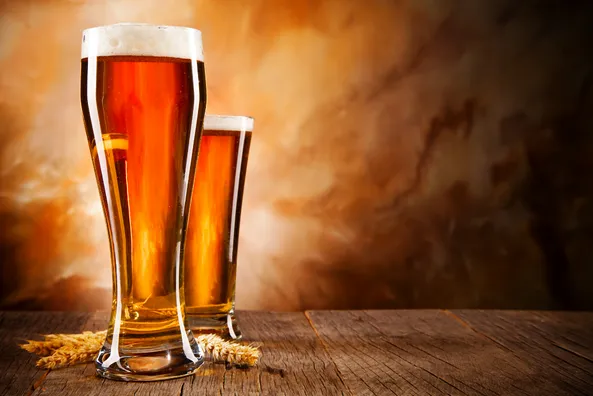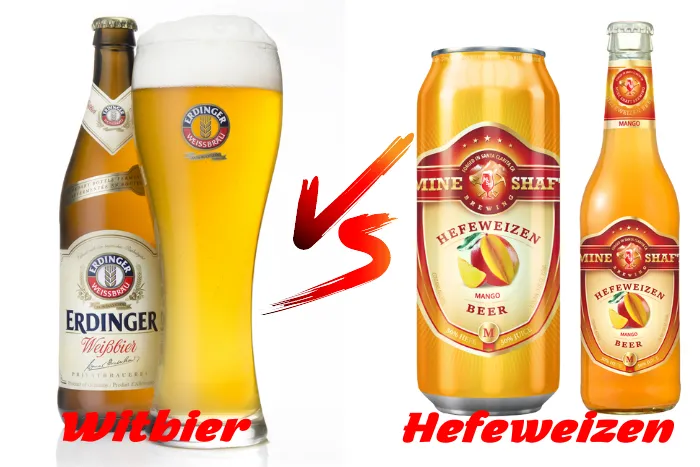Regarding suds, witbier and hefeweizen are two of the most beloved varieties. But what exactly sets them apart? We’ll compare both types of beer’s origins, ingredients, fermentation processes, flavor profiles, color variations, alcohol content, and IBU ratings in this article. We’ll list popular witbiers and hefeweizens and discuss their health effects. So let’s dive into an informative exploration about “witbier vs hefeweizen” – which is right for you?
Table of Contents:
- Origins and History of Witbier
- Ingredients Used in Witbier Brewing
- Fermentation and Brewing Process for Witbier
- Flavor Profile, Color, Alcohol Content, IBU, and Health Impact of Witbiers
- Popular Types Of Wibeers To Try
- FAQs in Relation to Witbier vs Hefeweizen
- Conclusion
Origins of Witbier

Belgium in the 16th century is credited with being the birthplace of witbier, known as hefeweizen or wheat beer. Hefeweizen, or witbier, is a pale straw-colored ale made with barley malt, coriander, and orange peel.
A long-time favorite for its invigorating taste and lower ABV, witbier has been a preferred beverage since the 16th century. “witbier” originates from the Dutch word for “white.”
History of Witbier
In the 1500s, Belgian monks brewed Witbier, which German brewers later called Hefeweizen (meaning “yeast wheat”). Bavarian brewers used different malts, hops, spices, and yeast strains to create unique flavors in the 19th century, making this beer style popular. Traditional Hefeweizen had clove notes, while Bavarian Hefeweizen had banana esters.
Popularity of Witbier
Witbier is popular in summer due to its light body, fruity aroma, and subtle sweetness. Pilsner and Vienna malts and noble hops like Hallertau Mittelfruh balanced bitterness, while orange peel and coriander add flavor complexity. American hefeweizens, unlike German weizens, are usually filtered and clearer.
Due to their crispness, witbiers pair well with stews and curries without overpowering them. They enhance citrusy flavors in salads and seafood like ceviche without overpowering them. Finally, home brewers who like experimenting with Belgian beers are making more witbiers.
Witbier has evolved over centuries, from its inception in the 16th century to becoming a widely-loved beer style today. The following section will explore some ingredients used in witbier brewing, including shared, unusual, and specialty ingredients.
Ingredients Used in Witbier Brewing
Witbier, or wheat beer, is a pale ale that originated in Belgium and Germany. Malted to a minimum of 50%, wheat is combined with barley malt to make witbier. The significant difference between witbiers and other beer styles is using unmalted wheat instead of barley malt. This gives it a lighter color, usually a pale straw yellow hue, than most beers. Witbiers are also spiced with coriander and orange peel for flavor.
Common Ingredients Used in Witbier Brewing:
Most brewers use traditional ingredients when making witbiers, such as malted wheat, barley malt, hops, yeast, coriander seeds, and orange peels. Malted wheat provides the body, while barley malt adds sweetness to the mix along with providing additional flavors like nuttiness or caramel notes, depending on what kind you choose.
Hops provide bitterness which balances out the sweetness from the grains. Yeast ferments sugars into alcohol, giving witbier-style beers their bubbly carbonation. Craft beer drinkers like this style because coriander seeds add a herbal aroma, and orange peels add citrusy notes.
Specialty grains are often used when brewing witbiers, including rye malts which impart spicy notes similar to those found in rye bread. Oats can also be added for smoothness and creaminess without being overly sweet. Additionally, Specialty yeast strains designed for this style can produce more complex aromas and flavors than regular ale yeasts.
The ingredients used in witbier brewing vary and can be tailored to individual tastes. Moving on from this discussion of ingredients, let’s now explore the fermentation and brewing process for witbiers.
Brewing Process for Witbier
Brewers worldwide have embraced witbier, known as hefeweizen or weissbier, for its traditional German wheat beer style. Pale straw color malts instead of dark roasted grains create a lighter body and mouthfeel.
Coriander or orange peel adds flavor characteristics such as clove, banana, bubblegum, and citrus fruit. The cloudy appearance is due to suspended yeast particles, and bottle conditioning gives it an effervescent carbonation. This brew has been a hit with many.
To achieve a balanced flavor, brewers often employ multiple hop varieties when crafting witbiers to counter malt sweetness. Noble hops like Hallertau Mittelfruh are used for their spicy aroma, complementing this beer’s flavors. Belgian Wit yeast adds complexity to this style and is popular with homebrewers.
Fermentation of Witbier
Mashing grains at low temps (150-160°F) is the initial step in witbier fermentation, allowing sugar extraction while maintaining a touch of residual sweetness. Brewers can start primary fermentation at 65-75°F after boiling wort with hops for 60 minutes and cooling below 80°F before adding yeast.
Keep oxygen levels low during primary fermentation to highlight yeast esters without overpowering oxidation flavors. After 4-7 days, brewers can transfer their beers to secondary vessels to condition for a week before bottling/kegging them.
Before capping your witbier, add enough priming sugar. Hence, there’s enough carbon dioxide available for natural carbonation during storage at room temperature (65-75°F).
This will ensure your beers have giant bubbles once chilled down and ready for serving. If all goes well, you should have a delicious light-bodied spiced beer with fish tacos or grilled chicken salads.
Fermenting and crafting witbier can be difficult, yet with the proper techniques, it is possible to create an outstanding brew. After discussing witbier fermentation and brewing, let’s compare its flavor, color, alcohol content, IBU levels, and health effects to hefeweizens.
Flavor Profile, Color, Alcohol Content, IBU, and Health Impact of Witbiers

Witbiers are a type of Belgian beer that have been brewed since the Middle Ages. They are characterized by their pale yellow color, light body, and high carbonation. Witbiers also contain spices such as coriander and orange peel, giving them a unique flavor profile. The flavor profile of witbiers is generally light and refreshing, with hints of citrus, spice, and maltiness.
Color of Witbier
The color of witbiers ranges from pale yellow to golden orange, depending on the wheat used in the brewing process. The use of wheat gives witbier its characteristic hazy appearance due to suspended yeast particles in suspension in the beer. This haze can range from barely noticeable to quite opaque, depending on how much wheat was used during brewing.
Alcohol Content in Witbier
The alcohol content for witbiers typically ranges between 4-5% ABV (alcohol by volume). This makes it a good choice for beer drinkers who want something flavorful but not too strong. Some craft brewers could have stronger ABV versions, so it’s wise to check before purchasing if you’re looking for something more potent than 5%.
IBU in Witbier
The bitterness of a beer is measured on the International Bitterness Unit (IBU) scale, which can range from 0 when no hops are added to hundreds depending on the style and recipe.
Witbiers usually fall somewhere around 10-20 IBU which puts them towards the lower end of bitterness compared to other styles like IPAs or Imperial Stouts, which can reach upwards of over 100 IBU.
Overall, Witbiers are an excellent choice for those who enjoy craft beers with complex flavor profiles and moderate alcohol content. Next, let’s delve into some of the more celebrated varieties of Witbiers.
Popular Types Of Wibeers
Regarding witbiers, a vast selection of tastes and styles exist for beer lovers to savor. Witbiers, or white beers, are a type of Belgian wheat beer that is light in color with an aroma with hints of citrus and spices like coriander and orange peel.
Witbiers have been a part of the brewing landscape since medieval times when they were brewed using unmalted wheat in combination with oats or barley. Today’s witbier recipes often include malted wheat and other grains such as spelled or rye.
The most popular types of witbiers are Blanche de Bruxelles, Hoegaarden Original White Ale, Wittekerke Belgian White Beer, Allagash White Ale, St-Feuillien Grand Cru Blanche, Ommegang Witte Wheat Beer, Celis White Ale and Pierre Celis Original Hoegaarden Witbier. The flavor of each variety may be distinctively sweet or tart based on the ingredients used in its fermentation.
Blanche de Bruxelles
It is a classic Belgian witbier made with barley malt extract instead of hops for bitterness; this gives it a slightly sweeter taste than some other varieties but still retains its characteristic citrusy notes from adding orange peel during the brewing process. It also contains coriander seeds, adding spicy notes to the beer’s flavor profile.
Pros: Sweet yet refreshing taste;
Cons: Not very hoppy, so not ideal for hop heads looking for more bitterness in their brews.
Hoegaarden Original White Ale
Another popular choice among craft beer drinkers is due to its unique blend of lemon zestiness and a subtle sweetness derived from using raw sugar during fermentation; this creates an incredibly flavorful combination that many find irresistible.
Pros: Complex yet balanced flavor profile;
Cons: Slightly higher alcohol content (5%) compared to some other wits making it less session-able than others at just 4%.
Wittekerke Belgian White Beer
It is brewed using traditional methods such as open fermenting in wooden vats rather than stainless steel tanks giving it an unmistakable depth of character you won’t find elsewhere. Its complex flavor combines elements ranging from honeyed fruitiness through herbal undertones courtesy of fresh coriander seed additions before bottling time – indeed, something special.
Pros: Complex yet balanced flavors;
Cons: More expensive than mass-produced lagers due to artisanal techniques used in the production process.
Allagash Brewing Company
Hailing from Portland, they debuted their cherished White Ale in 1995, one of the brewery’s most outstanding achievements. This beer stands out from the pack with its creamy texture, delightful aromas of clove-like phenols, and subtle fruity esters from specially selected yeast strains. Those looking for a bit more hop-kick might find it lacking, but this is worth trying for those who appreciate something different.
St-Feuillien Grand Cru Blanche
Uses old-world ingredients, including locally sourced buckwheat flour, and modern techniques resulting in a smooth body packed with full flavourful nuances ranging from floral hints right through a peppery spice finish – genuinely remarkable. Pros: Smooth mouthfeel and great flavors make a delightful drinking experience; Cons: Abv 8% is relatively high compared to similar-style beers.
Ommegang Witte Wheat Beer
Combines a traditional witbier recipe featuring unmalted wheat, oats & barley alongside an American twist adding cascade hops late boil stage, imparting a slight hint of grapefruit complimented subtle pepper finish – worth trying. Pros: Unique mix old world new world flavors give exciting take on a classic style; Cons: Abv 5 % lower end scale when compared to similarly styled brews meaning may lack punch desired by some drinkers.
Celis White Ale
was created by Pierre Celis 1980s in Belgium and is now being continued by his daughter Christine America using the same secret family recipe renowned worldwide ever since – a fantastic example original version crafted over 30 years ago. Pros: Full-bodied flavor rich malty backbone complemented by pleasant yeasty spice notes; Cons: Limited availability outside the US means challenging to get hold of unless imported online.
FAQs in Relation to Witbier vs Hefeweizen
What’s the difference between a Witbier and Hefeweizen?
A Witbier and Hefeweizen are wheat beer types but have some critical differences. A Witbier is a Belgian-style beer, typically pale yellow in hue and with an ABV of 4%-5%, featuring unmalted wheat, coriander, and orange peel for a tart flavor. It has an ABV of 4%-5% and is usually pale yellow. Conversely, Hefeweizen is a German-style wheat beer combining malted barley and unmalted wheat to create a distinctively hazy look. It is typically characterized by banana and clove notes with an ABV of 4%-6%. Its flavor profile includes banana and clove notes due to the use of specific yeast strains during fermentation; this style typically has an ABV ranging from 4%-6%.
What is the difference between a Hefeweizen and a wheat beer?
Hefeweizen and wheat beer are both types of German-style beers. Hefeweizens are brewed with malted barley, unmalted wheat, yeast, and hops. They typically have a hazy appearance due to suspended proteins from the wheat in suspension. The flavor is usually characterized by banana or clove aromas and flavors and hints of citrusy fruitiness from the yeast strain used during fermentation. On the other hand, wheat beers use primarily malted wheat instead of barley for their grain bill, which gives them a lighter body than Hefeweizens and makes them more prone to cloudiness over time if not stored properly. Additionally, they tend to be less fruity in aroma/flavor than Hefeweizens due to differences in yeast strains used during fermentation.
What is the difference between Weiss and Wit beer?
Weiss and Wit beer are wheat beers originating in Germany but have distinct differences. Weissbier is a top-fermented brew made with malted barley and wheat. At the same time, Witbier has unmalted grains such as wheat, oats, or barley added during fermentation to impart its unique spicy flavor. The taste of Weissbeer has more sweetness due to the higher malt content, which gives it notes of banana and clove. In comparison, Witbier is spicier with hints of coriander and orange peel because these spices are added during fermentation for flavor. Both styles are light-bodied beers that can be enjoyed year-round.
What beer is similar to Hefeweizen?
Its yeast gives it a light, refreshing taste with banana and clove notes. Kristallweizen, Dunkelweizen, Weizenbock, Gose, and Berliner Weisse are other wheat beers that share a pale colour and low bitterness but differ in strength and complexity due to different fermentation processes or ingredients. These styles have a pale yellow colour and low bitterness, but their fermentation processes and ingredients vary in strength and complexity.
Conclusion
In conclusion, witbier and hefeweizen beers are both unique in their ways. Both beers possess a remarkable taste that connoisseurs of craft brews can savor. Witbiers tend to have higher alcohol content than Hefeweizens but also lower IBU ratings. Regarding health impact, the two types of beers offer similar benefits, such as increased Vitamin B intake and improved digestion due to their probiotics. Whether you prefer witbier or hefeweizen for your next drink is up to personal preference – why not try out some popular varieties from each style, like Hoegaarden White Ale or Paulaner Hefe-Weisse?
Discover the best of witbier and hefeweizen with Brew Publik. Join us to find your perfect brew as we explore beer reviews, equipment, subscription services, and beer-making techniques!
Also See: Exploring the Differences Between IPA and Imperial IPA

